
A cocktail is a mixed drink, usually alcoholic. Most commonly, a cocktail is a combination of one or more spirits mixed with other ingredients, such as juices, flavored syrups, tonic water, shrubs, and bitters. Cocktails vary widely across regions of the world, and many websites publish both original recipes and their own interpretations of older and more famous cocktails.

A Manhattan is a cocktail made with whiskey, sweet vermouth, and bitters. While rye is the traditional whiskey of choice, other commonly used whiskies include Canadian whisky, bourbon, blended whiskey, and Tennessee whiskey. The cocktail is usually stirred with ice then strained into a chilled cocktail glass and garnished traditionally with a maraschino cherry. A Manhattan may also be served on the rocks in a lowball glass.
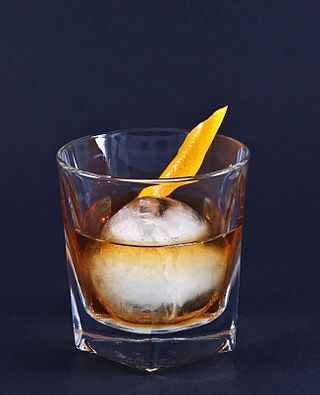
The old fashioned is a cocktail made by muddling sugar with bitters and water, adding whiskey or sometimes brandy, and garnishing with an orange slice or zest and a cocktail cherry. It is traditionally served with ice in an old fashioned glass.
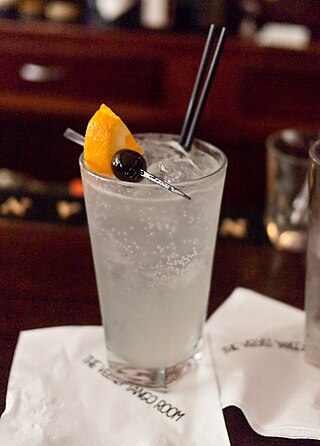
The Tom Collins is a Collins cocktail made from gin, lemon juice, sugar, and carbonated water. This "gin and sparkling lemonade" drink is typically served in a Collins glass over ice with a cherry garnish. A non-alcoholic "Collins mix" mixer is produced, enjoyed by some as a soft drink.

Rye whiskey can refer to two different, but related, types of whiskey:

The Sazerac is a local variation of a cognac or whiskey cocktail originally from New Orleans, named for the Sazerac de Forge et Fils brand of cognac brandy that served as its original main ingredient. The drink is most traditionally a combination of cognac or rye whiskey, absinthe, Peychaud's Bitters, and sugar, although bourbon whiskey is sometimes substituted for the rye and Herbsaint is sometimes substituted for the absinthe. Some claim it is the oldest known American cocktail, with origins in antebellum New Orleans, although drink historian David Wondrich is among those who dispute this, and American instances of published usage of the word cocktail to describe a mixture of spirits, bitters, and sugar can be traced to the dawn of the 19th century.
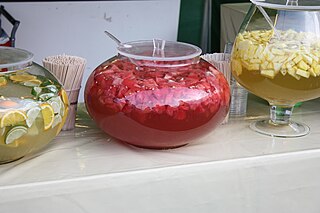
The term punch refers to a wide assortment of drinks, both non-alcoholic and alcoholic, generally containing fruits or fruit juice. The drink was introduced from the Indian subcontinent to England by employees of the East India Company in the late 17th century. Punch is usually served at parties in large, wide bowls, known as punch bowls.

A stinger is a duo cocktail made by adding crème de menthe to brandy. The cocktail's origins can be traced to the United States in the 1890s, and the beverage remained widely popular in America until the 1970s. It was seen as a drink of the upper class, and has had a somewhat wide cultural impact.

The rickey is a highball made from gin or bourbon, lime juice, and carbonated water. Little or no sugar is added to the rickey. It was created with bourbon in Washington, D.C., at Shoomaker's bar by bartender George A. Williamson in the 1880s, purportedly in collaboration with Democratic lobbyist Colonel Joe Rickey. Its popularity increased when made with gin a decade later. A non-alcoholic version is a lime rickey.
The Pendennis Club is a private social club located at 218 West Muhammad Ali Boulevard in Louisville, Kentucky. It originated as a gentlemen's "city" club on the model of the clubs in London, Britain, of which White's Club founded in 1693 is the progenitor. The Pendennis Club has long been regarded as the preeminent social club in Kentucky and one of the premier clubs in the United States.

The Prince of Wales is a cocktail created by Albert Edward, Prince of Wales, who later became King Edward VII. There are several variations of the cocktail, but what they usually have in common is champagne, angostura bitters, sugar, either rye whiskey or cognac, and a liqueur.
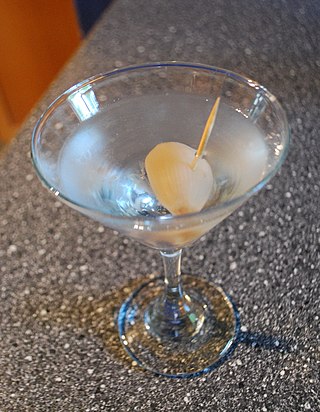
The Gibson is a mixed drink made with gin and dry vermouth, and often garnished with a pickled onion. In its modern incarnation, it is considered a cousin of the ubiquitous martini, distinguished mostly by garnishing with an onion instead of an olive. But the earliest recipes for a Gibson – including the first known recipe published in 1908 by Sir David Austin – are differentiated more by how they treat the addition of bitters.
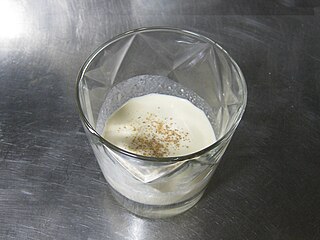
Milk punch is a milk-based brandy or bourbon beverage. It consists of milk, the spirit, sugar, and vanilla extract. It is served cold and usually has nutmeg sprinkled on top. Milk punch may be clarified through the addition of ingredients which cause the milk to curdle, so that the solids contributing to the beverage's opacity may be strained out.
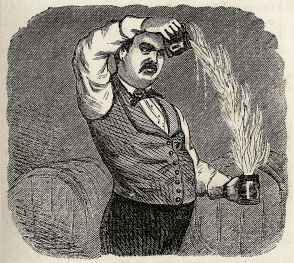
Jeremiah P. Thomas was an American bartender who owned and operated saloons in New York City. Because of his pioneering work in popularizing cocktails across the United States as well, he is considered "the father of American mixology". In addition to writing the seminal work on cocktails, Bar-Tender's Guide, Thomas displayed creativity and showmanship while preparing drinks and established the image of the bartender as a creative professional. As such, he was often nicknamed "Professor" Jerry Thomas.
Boker's Bitters was a brand of bitters manufactured by the L. J. Funke Company of New York City. The ingredient is specified in nearly every cocktail that called for bitters in Jerry Thomas' 1862 book, How to Mix Drinks or The Bon Vivant's Companion. Among the ingredients were quassia, cardamom, and bitter orange peel.
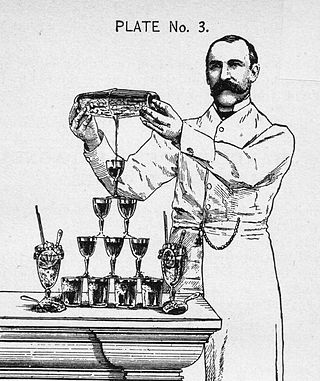
Harry Johnson was an American bartender who owned and operated saloons across the US in the late 19th century and the early 20th century. He is best known for the New and Improved Bartenders' Manual, an influential book that contained many original cocktail recipes, as well as the first written recipes of such cocktails as the marguerite and a version of the martini. Perhaps even more importantly, it was the first book to offer bar management instructions. Johnson opened the first ever consulting agency for bar management. Imbibe magazine has called him one of the most influential cocktail personalities of the last 100 years, and he has been called "the father of professional bartending".
A Green Swizzle is an alcohol-containing cocktail of the sour family. It was popular in Trinidad at the beginning of the 20th century but got lost during the course of the Second World War. Today's recipes usually constitute an often distinct divergence from the original.

The craft cocktail movement is a social movement spurred by the cocktail renaissance, a period of time in the late 20th and early 21st century characterized by a revival and re-prioritization of traditional recipes and methods in the bar industry, especially in the United States. The renaissance was followed by innovation and new techniques, and the movement has spread globally, now forming part of global cuisine.

The Oxford Companion to Spirits & Cocktails (OCSC) is a book in the series of Oxford Companions published by Oxford University Press. The book provides an alphabetically arranged reference to spirits, cocktails and other elements of the bar industry, compiled and edited by David Wondrich and Noah Rothbaum, with contributions by several writers including Doug Frost, Garrett Oliver and Audrey Saunders. Also notably contributing to the book is pioneering bartender Dale DeGroff. The work is considered the first reference book on the history and trends of distilled spirits.
















